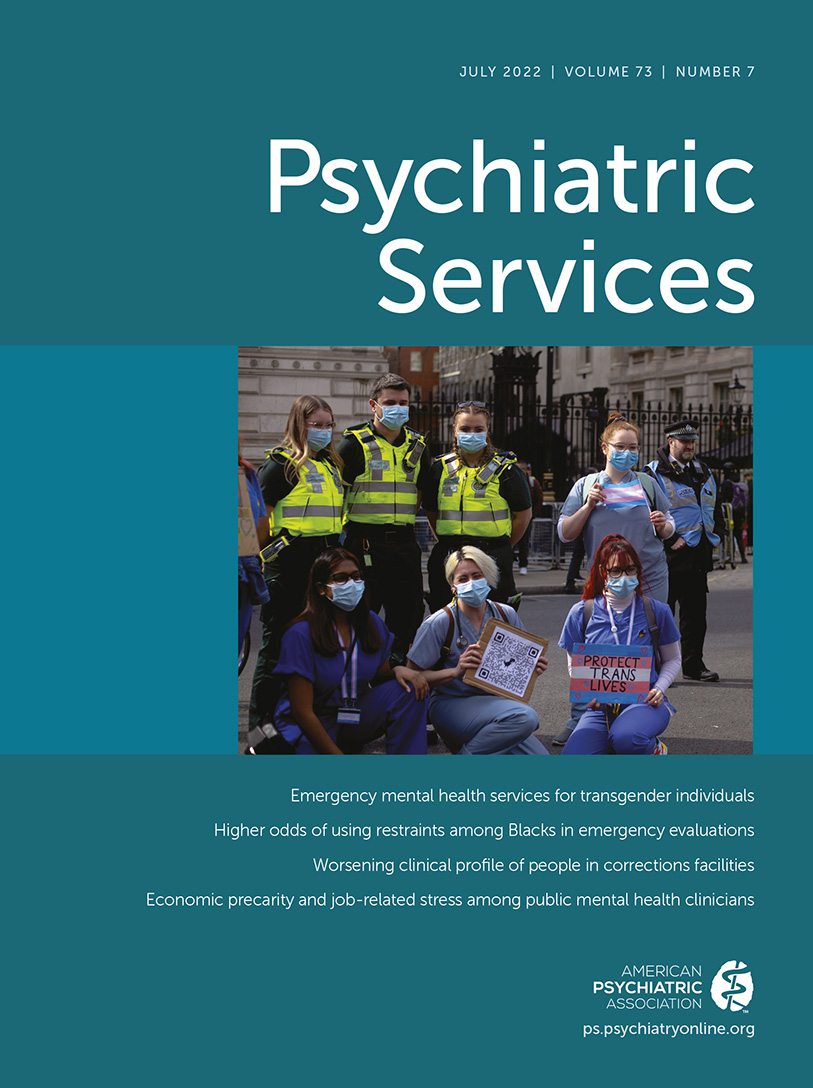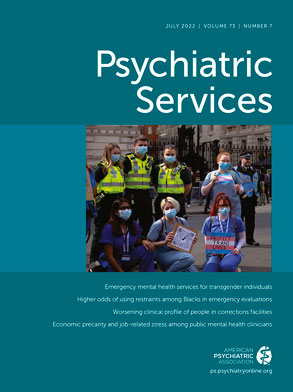Since the beginning of the COVID-19 pandemic (in early 2020), there have been repeated warnings that new and recurrent behavioral health disorders may increase among both COVID-19–infected and uninfected people (
1–
3). Increases in the rates of depression, anxiety disorders, and other behavioral health issues have been predicted and supported by self-reported survey data. However, few diagnostic data have been explored, especially in the United States, to support these hypotheses. The goal of this study was to examine whether behavioral health diagnoses or health care utilization increased during the first year of the pandemic era.
Some studies support the predictions of pandemic-related worsening of mental health. Early studies from China reported increased rates of anxiety disorders, depression, and posttraumatic stress disorder (PTSD). One of these studies reported high rates of general anxiety disorder and poor sleep quality—35.1% and 18.2% respectively—among adults in February 2020 (
4). A worsening of anxiety disorders for people who have a history of those problems also has been predicted. According to the report
America’s State of Mind (
https://www.express-scripts.com/corporate/americas-state-of-mind-report), the pharmacy benefit management company Express Scripts saw a 34.1% increase in antianxiety medication prescriptions during February and March 2020, most of which were new prescriptions. This finding is especially striking because antianxiety medication prescriptions had overall trended downward since 2015. Two literature reviews reported an increase in depressive symptoms during the pandemic (
5,
6). Many of these studies were based on self-report data collected via surveys (
7,
8); however, it is unknown whether the increases in depression and anxiety symptoms are being treated. Increases in anxiety and depressive symptoms that are not recognized and left untreated may lead to poor health outcomes.
Some evidence indicates that the pandemic has resulted in population-wide worsening of psychiatric symptoms, especially among people with preexisting psychiatric conditions (
9). A poll by the Kaiser Family Foundation found that nearly half of adults reported that their mental health has worsened because of worry and stress about COVID-19 (
10). A national survey of 1,441 adults during the first 2 weeks of April 2020 found increases in depression symptoms ranging from mild to severe during the pandemic compared with a prepandemic sample of 5,065 adults (
11). Another study of three cohorts of people interviewed before the pandemic and then during the months of March and April 2020 used the Brief Symptom Inventory to measure depressive symptoms and the Acute Stress Disorder Scale 5 to assess the acute stress response (
12). Both depressive symptoms and acute stress increased over time during the pandemic period. A multinational review of the literature of mental health consequences of COVID-19 published in April 2020 (
6) concluded that anxiety, depression, and self-reported stress were common psychological reactions to the pandemic.
There also has been speculation about how the mental and behavioral health of children and adolescents may be negatively affected by the pandemic (
13). According to a self-reported U.S. survey conducted nationwide during the pandemic, 27% of parents reported worsening mental health for themselves, and 14% reported worsening behavioral health for their children (
14). This observation corresponds to self-report studies from China, showing that 19% and 22% of students reported anxiety and depressive symptoms, respectively (
15). However, no U.S. studies using claims data are available to determine whether increases in pediatric behavioral health problems due to COVID-19 are being treated.
Most of the reports of worsening mental health during the pandemic have relied on surveys, polls, and self-reported data. These methods leave open the question whether individuals with mental health problems are being diagnosed and treated. Therefore, using data from several large health care systems that provide services for behavioral health care populations, we investigated whether the incidence of new behavioral health diagnoses increased during the first year of the pandemic era (March 2020–February 2021) compared with the same period a year earlier. This information is important for health care systems and clinicians who must prepare for any increase in demands on behavioral health services.
Methods
We used retrospective Medicaid claims data from five behavioral health care organizations with dates of service ranging from March 1, 2019, through February 29, 2020 (pre–COVID-19 period cohort), and March 1, 2020, to February 28, 2021 (COVID-19 period cohort). These entities included four regional managed care organizations and one state’s department of mental health serving persons with behavioral health conditions whose care was financed through Medicaid in midwestern and southern U.S. states. We included in the population every person who received at least one behavioral, general medical, or pharmacy service during the study period, because these data were available. In addition to gender, age, and race, we also recorded the top five mental disorders in each cohort, which were all collected from the claims data. We compared the number of new patients as well as new diagnoses of anxiety and depression. A new case was defined as an individual without a claim in the data set in the previous 12 months. We compared cases of depression, anxiety, PTSD, adjustment disorder, reactive stress disorder, and alcohol and other drug use disorder among children ages ≤17 years, adults 18–64 years, and adults ≥65 years. We also investigated cases of oppositional defiant disorder, conduct disorder, and attention-deficit hyperactivity disorder in the child cohort. Claims definitions for all disorders can be found in an
online supplement to this report. Finally, we compared the number of hospitalizations and emergency department visits and outpatient service use during the pandemic with those in the year before. Institutional review board exemption was received from the Center for Outcomes Analysis.
We used logistic regression to examine whether the proportion of participants with the presence of one of the outcome variables changed from the prepandemic to the postpandemic period. Because the data set from both periods contained data from some of the same participants, we accounted for repeated observations by running an advanced form of logistic regression for clustered data within the generalized estimating equations statistical framework. This framework belongs to the generalized linear model family that uses a robust variance estimator to account for repeated observations, which tend to decrease standard errors of measurement and hence artificially increase the chances of statistically significant results.
Results
Applying our inclusion criteria, we identified 893,284 children, 681,288 adults, and 141,300 older adults in the pre–COVID-19 cohort, and 812,344 children, 649,237 adults, and 127,530 older adults in the COVID-19 cohort. The two cohorts were similar in terms of demographic characteristics (see Table
1) and the top five mental disorders (see table in the
online supplement).
The number of new patients served by these behavioral health care organizations significantly increased during the COVID-19 period (p<0.001). Further, the numbers of both adult patients having received a new diagnosis of anxiety disorders (p<0.001) and children having received a diagnosis of depression (p<0.001) increased during this period. (See table in the
online supplement for details by age.) Differences in health care utilization between the two periods for most outcomes were too small to represent important differences at the population level; however, nonbehavioral health emergency department visits meaningfully and statistically significantly decreased across all age groups during the COVID-19 period (p<0.001). (See table in the
online supplement.) Statistically significant differences in the percentage of the population with a variety of behavioral health diagnoses were observed for all age groups, but these differences most likely were too small to represent an important difference at the population level. (See table in the
online supplement.)
Discussion
Given all the stressors people have experienced during the COVID-19 pandemic, including enforced isolation and school closures, many researchers, clinicians, and public health officials have predicted that the pandemic would lead to a mental health crisis. To our knowledge, this study is one of the first to use prescription and diagnostic data rather than self-reports and questionnaires to understand behavioral health trends during the pandemic to assess this prediction. Our data on psychiatric diagnoses and health care utilization experienced by a large population of patients enrolled in behavioral health care programs only partially support the concern that psychiatric morbidity rates and demand for health care services would substantially increase as a result of the pandemic. We found increases in the number of new patients entering behavioral health care systems and some increases in the number of new diagnoses of anxiety disorders and depression; however, we observed no increase but rather a decrease in health care utilization in the first year of the pandemic era compared with the prepandemic period the year before.
Similar results were reported from the United Kingdom (
16), where first diagnoses of depression and anxiety were significantly lower in April 2020 than expected; by September 2020, however, rates of anxiety and depression had returned to anticipated levels. These findings are further supported by cross-sectional data from the Centers for Disease Control and Prevention, which showed a drop in total emergency department volume in March of 2020 among those with mental health conditions; however, these data also showed that visits began to return to normal in April 2020 (
17).
Our study had several limitations. First, we used Medicaid claims data to identify cases and service utilization. Although claims data have been shown to accurately reflect these variables (
18,
19), such data may contain errors due to coding mistakes and incomplete data entry. However, we would expect such errors to have equally affected data from both the prepandemic and pandemic eras and therefore not to have influenced our results. Also, because the study population included only individuals with Medicaid, the results may not represent the outcomes and experiences of uninsured or privately insured populations. Second, although we used data from multiple behavioral health care systems with broad geographical representations and from a large sample, it is possible that our results may not generalize to other areas of the United States and to all racial-ethnic groups. During the analysis period, new COVID-19 infections spread from northeastern states across the South and Midwest, finally engulfing the entire nation by late fall 2020 (
20). Third, the individuals in this study were enrolled in behavioral health care. Therefore, data from individuals in the general population might yield different results. Finally, many other confounding factors not accounted for in the current analysis may exist and may have influenced the results, such as changes in the availability of mental health services, a shift toward telehealth, differences in social support, and other events concurrent with the pandemic.
Conclusions
Our findings suggest that the number of people who experienced anxiety and depression during the first year of the COVID-19 pandemic increased compared with prepandemic numbers. Perhaps because of decreased access to health care services, the increased stress of the pandemic did not result in greater health care service use. A major clinical concern is that individuals with new-onset psychiatric illness or exacerbation of existing psychiatric illness did not get appropriate care during the early months of the pandemic. Such lack of available care could result in many people with untreated and therefore more severe illness who may present for treatment later in the pandemic. Collection and analysis of follow-up data as the pandemic progresses will be crucial to fully understand its impact on behavioral health outcomes and on the health care field at large.

